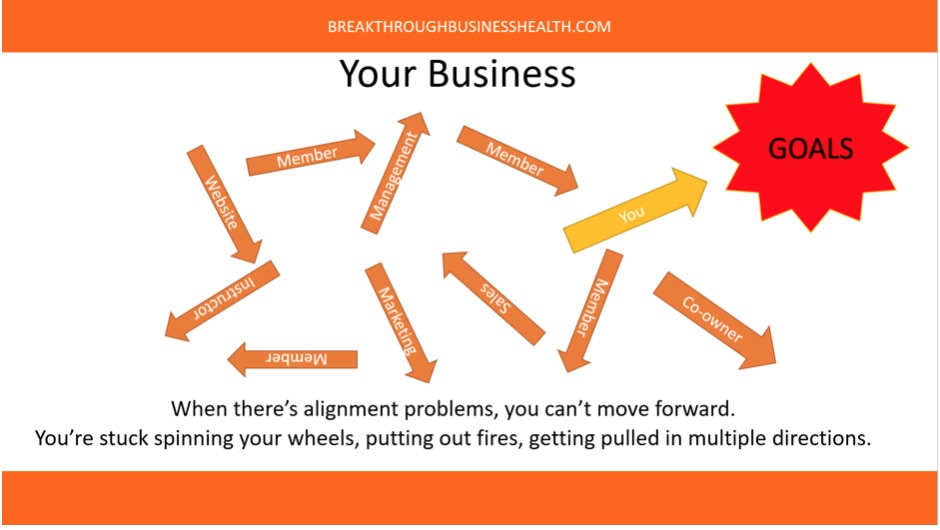 By Brandon Nicholas, Special AFS Contributor
By Brandon Nicholas, Special AFS Contributor
How many hours a week are you spending in your business on things you'd rather not do? How much time are you spending on managing people and dealing with finances? Are you thinking, "I'd like to cut the time I spend on these things but I can't. This is how it's done."
This is far from the truth and there is a better way. The fundamental factor is creating alignment among all the parts in your business.
When you do a google search for the definition of 'alignment' you get:
- Arrangement in a straight line, or incorrect appropriate relative positions.
- A position of agreement or alliance.

When you don't have alignment, everything is moving in different directions, not working together; You have members confused on the program or upset about the payment system, instructors that are only putting in the minimal possible effort or difficult to work with, and possibly a manager or co-owner that is difficult to work with.
Without everything pointing in the same direction, it can be a slow struggle or be virtually impossible to reach your goals.
When you have true alignment:
- You have a manager that deals with all the regular challenges you would rather not deal with.
- You have instructors that show up before sessions and stick around after to help out members.
- You have eager, happy and engaged members that organically help your studio grow by bringing new people in.
- You aren't running around just trying to keep up and put out fires.
- You're able to work on starting up that next location or get back to spending more time working one on one with clients or whatever you prefer!
 When you have your alignment figured out, your business is a well-oiled machine, with everyone and everything working together in the same direction.
When you have your alignment figured out, your business is a well-oiled machine, with everyone and everything working together in the same direction.
How do you create alignment?
To get there, you need to work on what I call your Alignment Plan. Your Alignment Plan is a system that gets everyone on board with the bigger picture and the nitty-gritty.
The major components to this are your:
- Vision
- Mission
- Principles
- Operating Procedures
You will want to work your way down this list starting with your creating your vision and mission and finishing up with your operating procedures.
Vision & Mission
Think of your mission and vision as the tip of your alignment spear: Your vision is an aspirational description of what you would like your organization to achieve or accomplish in the future. It is your desired end state or ideal long term goal. Your vision should look to solve a problem. It should have an emotional appeal. 
Here are some examples:
Tesla: To create the most compelling car company of the 21st century by driving the world’s transition to electric vehicles.
Amazon: To be Earth’s most customer-centric company, where customers can find and discover anything they might want to buy online.
LinkedIn: To create economic opportunity for every member of the global workforce.
Kaiser Permanente Healthcare: To be trusted partners in total health, collaborating with people to help them thrive and creating communities that are among the healthiest in the nation.
Mission: Where your vision focuses on the future and what you want your part of the world to look like, your mission focuses on the present and what your organization currently does to reach the future of your vision. It focuses on HOW you do what you do. Mission statements answer questions like:
- What do we do?
- Who are we trying to help?
- How do we help them?
Let’s re-visit the businesses we talked about above but this time look at their mission statement.
Tesla Mission: To accelerate the world’s transition to sustainable energy.
Amazon Mission: We strive to offer our customers the lowest possible prices, the best available selection, and the utmost convenience.
LinkedIn Mission: To connect the world’s professionals to make them more productive and successful.
Kaiser Permanente Healthcare Mission: We exist to provide high-quality, affordable healthcare services and to improve the health of our members and the communities we serve.
Your vision and mission don’t have to be as grandiose as some of these given examples. You can focus on creating your vision and mission for your local community, state, or nation. Whatever is best for you.
Principles
If your mission and vision make the tip of your spearhead, your principles are behind them making up the 'meat' of the spearhead. Compared to your mission and vision, they give more explanation in how your business shows up and takes action in the world but they are not step-by-step. Consider them as benchmarks and guidelines.
An organization can have as few as 5 or as many as 50 principles. It’s not how many you have that matters. It’s what is best for your organization.
Here are some example principles:
- Help members become a better version of themselves.
- Members and trainers come first, not the money.
- Always be honest with members and each other. Bait and switch tactics may make more sales in the short run but hurt in the long run.
- We always strive to grow and learn.
- We strive for a social climate that takes exercise seriously and yet makes the experience of exercise fun, and friendly. Our gym is a good place to work, exercise, and play.
- All gym and work areas are kept clean and organized at all times.
- All routines are consciously built with the betterment of the member in mind. One routine may focus on one area or another, but over time, routines give a well-rounded fitness to strengthen and protect our members and trainers.
- Trainers are always at the gym at least 20 minutes before a session making sure everything is ready and in its place and there to welcome members.
When you have your alignment figured out, your business is a well-oiled machine, with everyone and everything working together in the same direction.
Standard Operating Procedures
If the vision, mission, and principles make the head of the spear, the operating procedures are the handle of the spear. It is where actual traction is made that pushes the whole spear forward to its goal. Standard operating procedures eliminate ambiguity and confusion on how something is done, minimizing and eliminating errors.
Standard operating procedures are where you get into the nitty-gritty details, where re-occurring work gets documented step by step.
Here are some example procedure topics that should be documented:
- How a sales call is made.
- How the phone is answered and where to direct calls.
- How new work out routines are made.
- How new members are on-boarded.
- How new trainers are on-boarded.
The basic rule of thumb: if something gets done more than once, there should be documentation on how to do it. You can use video, audio, written instructions or a mix of what you find works best for your situation.
As you start to document your operating procedures you will have started to create a system that does the heavy lifting for you. A system that you or anyone on your team can refer to when they have questions and keeps them aligned with your program and goals. Your whole team knows and understands how things are supposed to work and instead of making mistakes, being difficult to work with or just putting in the minimum effort, they are all succeeding in their work and enjoying everything much more.
This is where you'll start to see the magic happen. This is where your time managing and doing less exciting tasks fall back more and more.
Keep in mind, this process of creating alignment in your business takes time to do it right and there will be a level of refining for a long time. But the work is well worth it. Be patient with yourself and the process, and in time you will have created a business and lifestyle exactly the way you want it.
Brandon Nicholas is the Founder and CEO of Breakthrough Business Health. Brandon has spent the last two decades studying and applying best business practices to his own businesses and helping coach others in their own businesses. Through coaching and consulting, he's dedicated to helping you grow your membership, open up that next location, cut your time managing people in half so you can spend more time doing what you love.


Join the Conversation!